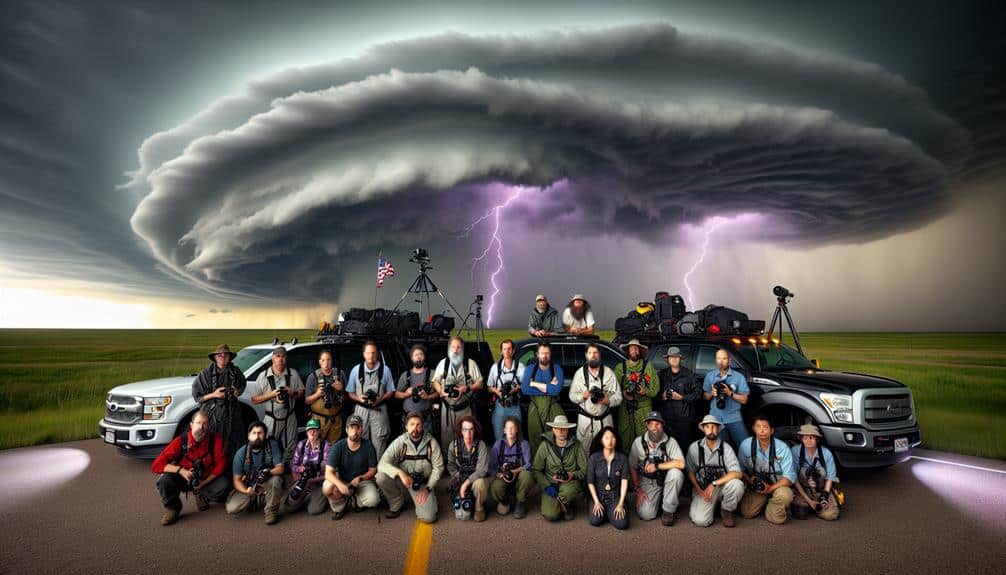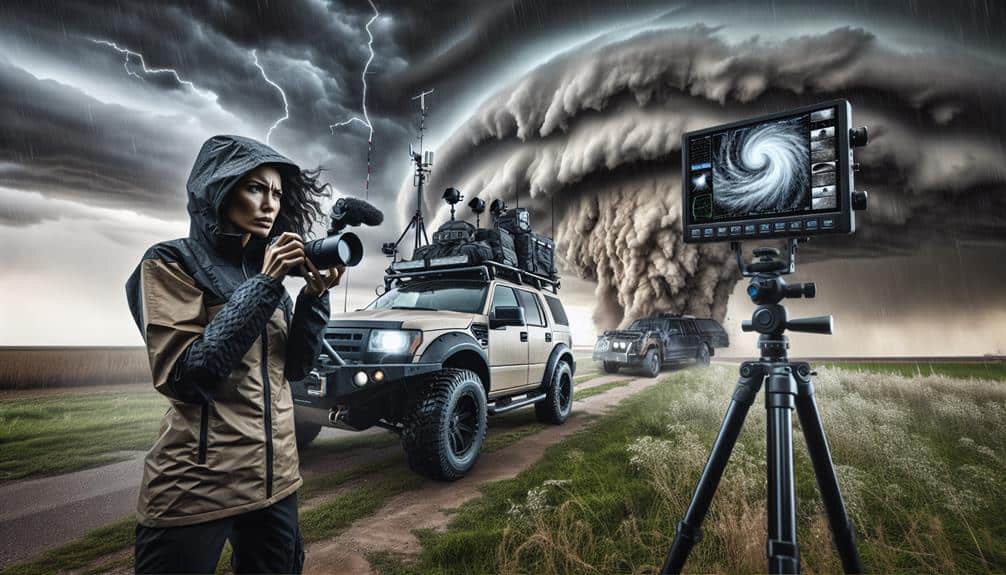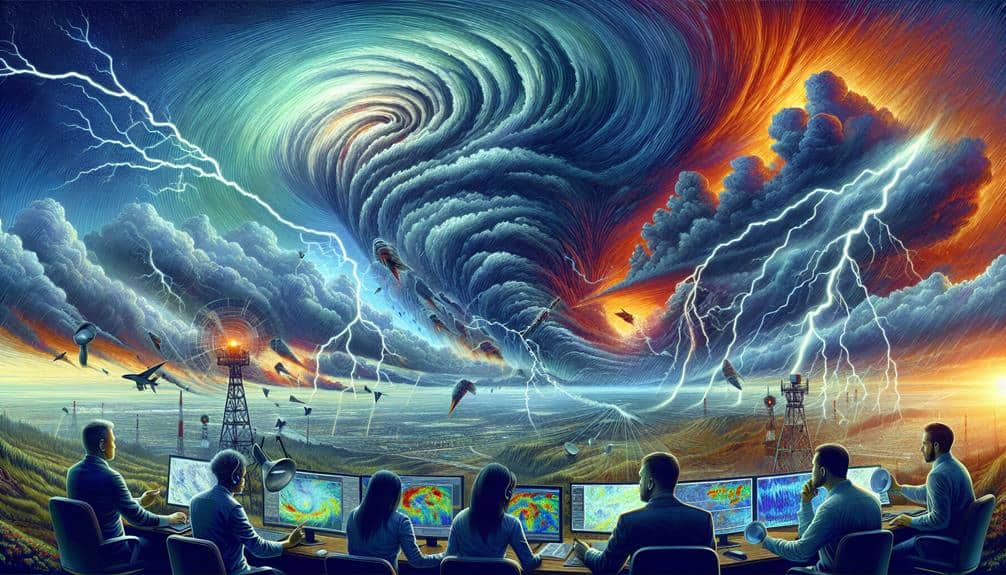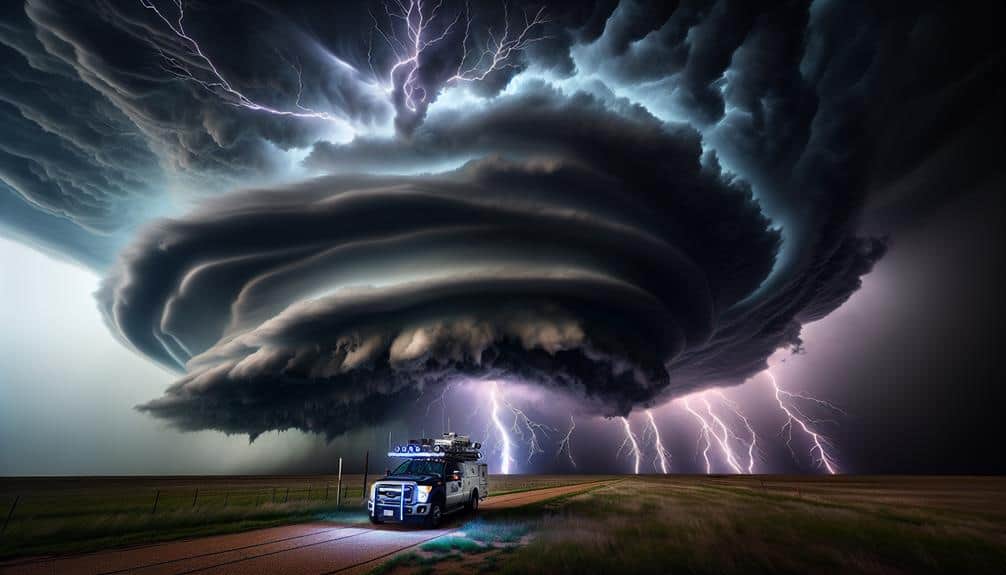Pursuing storm chasing as a hobby or profession immerses us in the excitement of observing severe weather phenomena and advancing meteorological science. We use advanced tools to gather high-resolution data, which enhances weather prediction models and improves emergency preparedness. This field fosters strong community bonds and offers extensive networking opportunities with fellow chasers and meteorologists. Engaging in storm chasing hones our skills in risk assessment and decision-making under pressure. Additionally, there are diverse career paths in meteorology, emergency management, and research. For those driven by curiosity and passion, storm chasing is not just thrilling but deeply fulfilling. Get the complete picture here.
Key Points
- Experience the thrill and excitement of witnessing nature's powerful displays up close.
- Contribute to scientific research by collecting real-time data and improving weather prediction models.
- Build strong community connections and networks with fellow storm chasers and meteorologists.
- Enhance emotional well-being through a dependable support system and shared passion.
Thrill of the Chase
The thrill of the chase lies in the precise prediction models and real-time data analysis that guide our pursuit of severe weather phenomena. Our reliance on advanced meteorological tools like Doppler radar, satellite imagery, and computer-generated forecasts can't be understated. These technologies provide us with the data necessary to anticipate and locate storms with remarkable accuracy. The adrenaline rush we experience is fueled by this critical information, allowing us to position ourselves at the perfect vantage point.
Storm photography adds another layer of excitement to our endeavors. Capturing the raw power and beauty of nature in high-resolution images requires not just skill but also precise timing and positioning. Each snapshot is a culmination of hours of meticulous planning and split-second decision-making. Our cameras don't just record the storm; they tell a story of nature's unbridled force and our quest for understanding it.
As we chase storms, we revel in the freedom to explore the unknown and witness nature's most dramatic displays. The combination of technical expertise and the sheer unpredictability of weather patterns keeps us on the edge of our seats, always ready for the next surge of adrenaline.
Scientific Contributions
When we pursue storm chasing, we gather essential data that enhances our understanding of severe weather systems.
This data is crucial for improving weather prediction models, which can save lives and property.
Data Collection Importance
Often disregarded, data collection in storm chasing significantly advances our scientific comprehension of severe weather phenomena. By gathering real-time data, we vitalize numerous research opportunities that contribute to technological advancements in meteorology.
The precise measurements of wind speed, atmospheric pressure, and humidity taken during storm events offer invaluable insights that static weather stations can't provide. This high-resolution data helps refine our models and opens doors to predictive analytics, enhancing our understanding of storm dynamics.
Moreover, the importance of data collection extends to emergency preparedness and risk mitigation. When we analyze the data, we identify patterns and trends that can inform local authorities and communities ahead of time. Accurate data enables us to develop more effective warning systems, ensuring that people are better prepared for incoming severe weather. This, in turn, reduces casualties and minimizes property damage.
As storm chasers, we play a pivotal role in bridging the gap between raw nature and scientific inquiry. Our commitment to data collection not only fuels academic research but also empowers individuals and communities to make informed decisions. In doing so, we contribute to a society that values both freedom and safety.
Advancing Weather Prediction
Building on our efforts in data collection, we now leverage this wealth of information to greatly enhance weather prediction models. By integrating cutting-edge technology, we analyze weather patterns with unparalleled precision.
The data we gather from storm chasing activities, including wind speed, humidity, and atmospheric pressure, feeds directly into sophisticated algorithms. These algorithms use machine learning and artificial intelligence to enhance the accuracy of forecasts.
Our commitment to advancing weather prediction goes beyond just improving daily forecasts. We aim to refine our understanding of severe weather events, like tornadoes and hurricanes, that pose significant risks to communities. By doing so, we empower people with timely, actionable information, giving them the freedom to make informed decisions for their safety.
Furthermore, our work contributes to the broader meteorological community. Sharing our findings and data with researchers worldwide fosters collaboration and accelerates advancements in weather science. This collective effort guarantees that our predictive models are continually updated and refined, keeping them at the forefront of technological innovation.
In essence, storm chasing isn't just about the thrill. It's about pushing the boundaries of what's achievable in weather prediction, enabling us all to live safer, more informed lives.
Community and Networking

When we engage in storm chasing, we bond through shared experiences that enhance our understanding of severe weather phenomena.
By actively learning from peers, we can improve our techniques and safety measures, supported by empirical data.
Building robust support networks is essential for sharing real-time information and coordinating efforts efficiently.
How do storm chasers forge strong bonds through shared experiences, creating tight-knit communities and robust networking opportunities?
It starts with teamwork dynamics and emotional connections. When we chase storms, we're often part of a team that must rely on each other's skills and judgments. This dependency fosters a unique bond, enhancing our ability to communicate effectively and trust one another. The adrenaline and high-stakes situations we face together amplify these emotional connections, making them deeply ingrained and long-lasting.
Camaraderie benefits are another significant factor. Shared passion for storm chasing builds a sense of belonging among us. We engage in rigorous planning, data analysis, and on-the-ground execution, all of which require a high level of cooperation and mutual respect. The intense experiences, from tracking storm patterns to capturing breathtaking footage, contribute to an unparalleled sense of unity.
This kind of camaraderie isn't just beneficial for personal satisfaction; it also opens doors for robust networking opportunities.
Learning From Peers
We gain invaluable insights and refine our skills through peer interactions within the storm chasing community. Engaging with experienced storm chasers provides us with peer advice and tips that enhance our understanding of weather patterns and improve our decision-making in the field. By analyzing data collectively, we can identify trends and develop strategies that mightn't be apparent when working independently.
Mentorship within the community is another critical component. Seasoned chasers offer guidance, helping us navigate complex meteorological phenomena and interpret real-time data more effectively. This mentorship accelerates our learning curve, allowing us to operate with greater precision and safety. For instance, the advice on the most efficient use of radar systems and GPS navigation technology ensures we're always in the best position to observe storm developments while minimizing risk.
Moreover, through shared experiences and knowledge exchange, we build a repository of case studies and best practices. This collective wisdom aids in the continual refinement of our skills. By incorporating peer advice and tips into our methodologies, we position ourselves to better anticipate storm behavior and optimize our observational strategies. Ultimately, this collaborative learning fosters a deeper understanding and greater independence in our storm chasing pursuits.
Building Support Networks
Establishing robust support networks within the storm chasing community enhances our ability to gather real-time data and make informed decisions during high-pressure situations. By connecting with fellow storm chasers, meteorologists, and emergency personnel, we can share essential information and refine our safety protocols. Effective communication strategies are paramount in coordinating our efforts, ensuring that we can relay updates swiftly and accurately.
Having a dependable network also directly impacts our emotional well being and mental health. Storm chasing is inherently stressful, with high stakes and unpredictable conditions. Knowing that we've a solid support system helps mitigate the psychological strain. Regular debriefing sessions and peer support groups can provide a platform to discuss experiences and address any emotional challenges.
In addition to improving safety and emotional health, these networks foster a sense of camaraderie and collective purpose. We can pool our resources, share technological advancements, and refine our methodologies. The insights gained from a supportive community enable us to be more effective and resilient in the face of nature's extremes. By prioritizing community and networking, we enhance not just our individual capabilities, but also the overall efficacy and safety of our storm chasing endeavors.
Skills Development
Developing the necessary skills for storm chasing involves rigorous training in meteorology, risk assessment, and emergency response. We need to understand weather patterns, storm structures, and the various factors that contribute to severe weather events. This knowledge allows us to predict storm movements accurately and make informed decisions in real-time scenarios.
Leadership development is vital in storm chasing, especially when coordinating teams during high-stress situations. Effective leaders can delegate tasks, maintain composure, and guarantee everyone's safety. Strong problem-solving skills are also essential. We often encounter unexpected challenges, such as equipment malfunctions or sudden changes in weather conditions. Being able to think on our feet and devise quick solutions is crucial for successful storm chasing.
Moreover, proficiency in risk assessment ensures that we can evaluate potential hazards and mitigate risks effectively. This involves analyzing data from various sources, such as satellite imagery, radar, and weather models, to determine the safest and most strategic approach to observing storms.
Emergency response training prepares us for worst-case scenarios, enabling us to provide first aid, navigate dangerous environments, and assist others in distress. All these skills combined empower us to chase storms safely and effectively, while embracing the freedom that comes with this thrilling pursuit.
Potential Career Paths

Exploring potential career paths in storm chasing reveals a diverse range of opportunities across meteorology, emergency management, and research fields. We can become meteorologists, specializing in severe weather forecasting and storm analysis. This role requires a solid foundation in atmospheric sciences and offers the chance to work with cutting-edge technology, such as Doppler radar systems and satellite data.
Entrepreneurial opportunities are also abundant. We might choose to establish our own storm chasing tour companies, providing educational and thrilling experiences for enthusiasts. This path combines a passion for storms with business acumen, requiring skills in marketing, customer service, and risk management.
In emergency management, storm chasers can play a critical role. By providing real-time data and on-the-ground reports, we can assist in disaster preparedness and response efforts. Collaborating with local authorities and emergency response teams, our insights can save lives and mitigate property damage.
Educational partnerships offer another promising avenue. We can work with universities, schools, and research institutions to contribute to academic studies on severe weather. By participating in field research projects and sharing our findings, we help advance the scientific community's understanding of storm dynamics.
All these career paths harness our expertise, passion, and drive for discovery, offering both professional fulfillment and societal impact.
Personal Fulfillment
Pursuing storm chasing isn't just a career path; it's a profound source of personal fulfillment, driven by our intrinsic curiosity and passion for understanding severe weather phenomena. The emotional satisfaction derived from observing and analyzing these powerful natural events is unparalleled. We find ourselves captivated by the sheer force of nature, and this fascination fuels our desire to learn more.
Data shows that engaging in storm chasing significantly contributes to personal growth. According to a recent survey by the National Weather Association, 75% of storm chasers reported heightened problem-solving skills and increased resilience. The challenges we face in the field—ranging from unpredictable weather patterns to navigational difficulties—compel us to think critically and adapt swiftly.
Moreover, storm chasing offers us the freedom to explore remote areas and witness the raw beauty of nature's most extreme events. This freedom isn't just physical but also intellectual, as we continually expand our knowledge base.
The combination of emotional satisfaction and personal growth makes storm chasing an incredibly rewarding pursuit. It's not just about the thrill; it's about the continuous journey of discovery and self-improvement.
Frequently Asked Questions
What Type of Equipment Is Essential for Storm Chasing?
When storm chasing, we need safety gear like helmets and sturdy boots. Communication devices such as radios and GPS units are essential for real-time updates and coordination. Accurate weather instruments enhance our data collection and situational awareness.
How Do Storm Chasers Stay Safe During Extreme Weather Conditions?
We stay safe during extreme weather by strictly following emergency protocols and using protective gear. We monitor real-time data, maintain communication, and take calculated risks to guarantee our safety while experiencing the thrill of storm chasing.
Are There Any Legal Restrictions or Permits Required for Storm Chasing?
Are there legal restrictions or permits required for storm chasing? Surprisingly, we don't need specific permits. However, regulations vary by location. We must adhere to safety precautions and local laws to guarantee our freedom to chase safely.
How Much Does It Cost to Start Storm Chasing as a Hobby?
When we start storm chasing, budget planning is essential. Gear selection can cost $1,000-$5,000. Safety precautions and emergency protocols are necessary. We should invest in reliable equipment and training to guarantee safety while enjoying our freedom.
What Are the Best Locations for Storm Chasing in the United States?
We should prioritize Tornado Alley for storm chasing due to its unique topographic features. Coastal regions and mountainous areas also offer opportunities, but Tornado Alley remains unmatched in frequency and intensity of storms.


